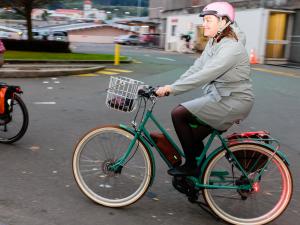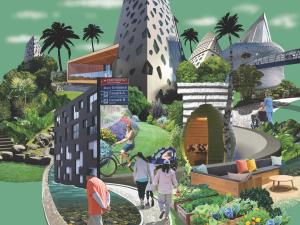Respiratory physician Lutz Beckert considers chronic obstructive pulmonary disease management, including the prevention of COPD, the importance of smoking cessation and pulmonary rehabilitation, and the lifesaving potential of addressing treatable traits. He also discusses the logic of inhaler therapy, moving from single therapy to dual and triple therapy when indicated, as well as other aspects of management
Covering bases in Bay of Plenty
Covering bases in Bay of Plenty

- The audit organisation Toitū reports Bay of Plenty DHB’s 2020/21 greenhouse gas emissions are down 243.79 tonnes of carbon dioxideequivalent compared with 2018/19.
- The DHB board in 2019 approved a plan to support reduced travel by staff and patients.
- Food waste from the DHB’s Tauranga offices goes to a worm farm on a trial basis; that’s four tonnes a month less going to landfill.
Is my local doctors’ clinic far from where I live, or is it 6 or 7km down a hill through a valley…close to the estuary and in a flood zone?
Of all the places to be based as a DHB sustainability manager, Vicktoria Blake hit the jackpot – but not always in a good way.
Living in the sunny Bay of Plenty port city of Tauranga, Ms Blake is wide awake to the climate emissions generated by vehicles.
“Travel is a key component of our emissions profile in New Zealand,” she says, “because we love our cars and, in Tauranga, we have the fastest-growing fleet and the worst congestion issues in the country.” Sixty-one per cent of the city’s carbon footprint comes from transport emissions.
The DHB’s own travel is covered by a range of strategies in a plan approved by the board in 2019. While data is key to climate action, DHBs don’t yet measure the carbon footprint of patient and visitor travel and staff commuting. Doing so would likely show a measured carbon footprint that’s twice as high as the official one.
Beyond the DHB, Ms Blake is a health-sector voice and facilitator of the Greater Tauranga Travel Pledge.
Most large public and private sector employers have signed the pledge, to be more flexible on working/commuting hours, encourage walking and cycling, and to bring down carbon emissions related to travel.
The DHB is ordering its first 20 electric vehicles – co-funded by the State sector decarbonisation fund – and is also reducing the energy consumption of its buildings.
With a Masters of Environmental Management and a background in sustainability and leadership education, Ms Blake joined the DHB three years ago. COVID-19 has added to the challenges of the role.
Still, from early on, she and a “green team” have been providing online and in-person sessions for staff on sustainability and efforts they can join.
She spread word, too, about the need to take a reading of the board’s climate risks overall. Bay of Plenty became the first DHB to complete this exercise. It means there’s a risk register available to help inform plans for health infrastructure and services.
Ms Blake is on the working group that’s responsible for the Bay of Plenty region’s climate change risk assessment process.
For years, international and national experts have laid out the threats of a warming world: new vectors spreading disease; food and water insecurity; heat-induced hospitalisations; mental health declines; forced depopulation of flood-prone areas; and more.
Ms Blake says a wide view must be taken of the effects of all these on local services. This will include location: “Is my local doctors’ clinic far from where I live, or is it 6 or 7km down a hill through a valley…close to the estuary and in a flood zone?
“Are we planning enough wards to cope with the older patients impacted by increased heat?”
Running an organisation sustainably puts the focus on the products it uses: the emissions spent in making and transporting them, and their durability. Ms Blake says the procurement team increasingly uses that information in its decisions. She herself gives sustainability input to the product evaluation group.
Many staff are doing their bit. In the past few years, recycling programmes have been extended at both Tauranga and Whakatāne hospitals.
Recyclables are separated out, similarly as with households, but with numerous extra diversion routes for particular products. For example, polystyrene goes to manufacturer Expol, which uses it in a building product.
In a trial, a local worm-farm operator is making use of the Tauranga offices’ food waste – that’s four tonnes a month less going to landfill. The hope is to expand the scheme to all organic waste from both hospitals.
Audit organisation Toitū reports Bay of Plenty DHB’s 2020/21 greenhouse gas emissions are down 243.79 tonnes of carbon dioxide-equivalent compared with 2018/19.
We're publishing this article as a FREE READ so it is FREE to read and EASY to share more widely. Please support us and the hard work of our journalists by clicking here and subscribing to our publication and website







![Barbara Fountain, editor of New Zealand Doctor Rata Aotearoa, and Paul Hutchison, GP and senior medical clinician at Tāmaki Health [Image: Simon Maude]](/sites/default/files/styles/thumbnail_cropped_100/public/2025-03/Barbara%20Fountain%2C%20editor%20of%20New%20Zealand%20Doctor%20Rata%20Aotearoa%2C%20and%20Paul%20Hutchison%2C%20GP%20and%20senior%20medical%20clinician%20at%20T%C4%81maki%20Health%20CR%20Simon%20Maude.jpg?itok=-HbQ1EYA)
![Lori Peters, NP and advanced health improvement practitioner at Mahitahi Hauora, and Jasper Nacilla, NP at The Terrace Medical Centre in Wellington [Image: Simon Maude]](/sites/default/files/styles/thumbnail_cropped_100/public/2025-03/2.%20Lori%20Peters%2C%20NP%20and%20advanced%20HIP%20at%20Mahitahi%20Hauora%2C%20and%20Jasper%20Nacilla%2C%20NP%20at%20The%20Terrace%20Medical%20Centre%20in%20Wellington%20CR%20Simon%20Maude.jpg?itok=sUfbsSF1)
![Ministry of Social Development health and disability coordinator Liz Williams, regional health advisors Mary Mojel and Larah Takarangi, and health and disability coordinators Rebecca Staunton and Myint Than Htut [Image: Simon Maude]](/sites/default/files/styles/thumbnail_cropped_100/public/2025-03/3.%20Ministry%20of%20Social%20Development%27s%20Liz%20Williams%2C%20Mary%20Mojel%2C%20Larah%20Takarangi%2C%20Rebecca%20Staunton%20and%20Myint%20Than%20Htut%20CR%20Simon%20Maude.jpg?itok=9ceOujzC)
![Locum GP Helen Fisher, with Te Kuiti Medical Centre NP Bridget Woodney [Image: Simon Maude]](/sites/default/files/styles/thumbnail_cropped_100/public/2025-03/4.%20Locum%20GP%20Helen%20Fisher%2C%20with%20Te%20Kuiti%20Medical%20Centre%20NP%20Bridget%20Woodney%20CR%20Simon%20Maude.jpg?itok=TJeODetm)
![Ruby Faulkner, GPEP2, with David Small, GPEP3 from The Doctors Greenmeadows in Napier [Image: Simon Maude]](/sites/default/files/styles/thumbnail_cropped_100/public/2025-03/5.%20Ruby%20Faulkner%2C%20GPEP2%2C%20with%20David%20Small%2C%20GPEP3%20from%20The%20Doctors%20Greenmeadows%20in%20Napier%20CR%20Simon%20Maude.jpg?itok=B0u4wsIs)
![Rochelle Langton and Libby Thomas, marketing advisors at the Medical Protection Society [Image: Simon Maude]](/sites/default/files/styles/thumbnail_cropped_100/public/2025-03/6.%20Rochelle%20Langton%20and%20Libby%20Thomas%2C%20marketing%20advisors%20at%20the%20Medical%20Protection%20Society%20CR%20Simon%20Maude.jpg?itok=r52_Cf74)
![Specialist GP Lucy Gibberd, medical advisor at MPS, and Zara Bolam, urgent-care specialist at The Nest Health Centre in Inglewood [Image: Simon Maude]](/sites/default/files/styles/thumbnail_cropped_100/public/2025-03/7.%20Specialist%20GP%20Lucy%20Gibberd%2C%20medical%20advisor%20at%20MPS%2C%20and%20Zara%20Bolam%2C%20urgent-care%20specialist%20at%20The%20Nest%20Health%20Centre%20in%20Inglewood%20CR%20Simon%20Maude.jpg?itok=z8eVoBU3)
![Olivia Blackmore and Trudee Sharp, NPs at Gore Health Centre, and Gaylene Hastie, NP at Queenstown Medical Centre [Image: Simon Maude]](/sites/default/files/styles/thumbnail_cropped_100/public/2025-03/8.%20Olivia%20Blackmore%20and%20Trudee%20Sharp%2C%20NPs%20at%20Gore%20Health%20Centre%2C%20and%20Gaylene%20Hastie%2C%20NP%20at%20Queenstown%20Medical%20Centre%20CR%20Simon%20Maude.jpg?itok=Z6u9d0XH)
![Mary Toloa, specialist GP at Porirua and Union Community Health Service in Wellington, Mara Coler, clinical pharmacist at Tū Ora Compass Health, and Bhavna Mistry, specialist GP at Porirua and Union Community Health Service [Image: Simon Maude]](/sites/default/files/styles/thumbnail_cropped_100/public/2025-03/9.%20Mary%20Toloa%2C%20Porirua%20and%20Union%20Community%20Health%20Service%20in%20Wellington%2C%20Mara%20Coler%2C%20T%C5%AB%20Ora%20Compass%20Health%2C%20and%20Bhavna%20Mistry%2C%20PUCHS%20CR%20Simon%20Maude.jpg?itok=kpChr0cc)